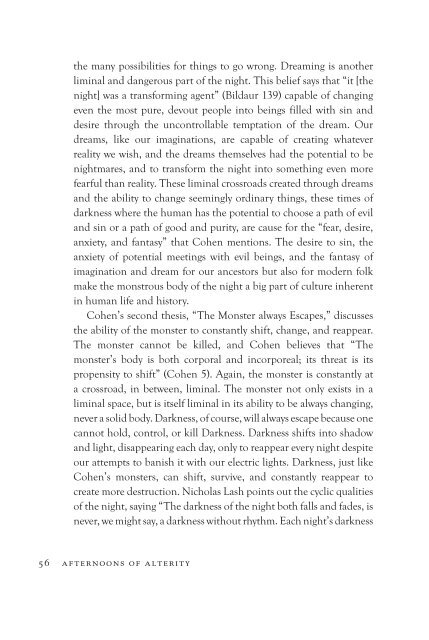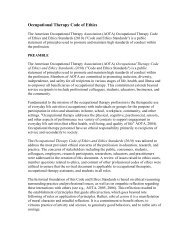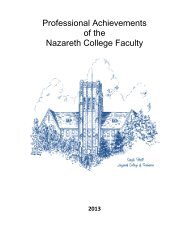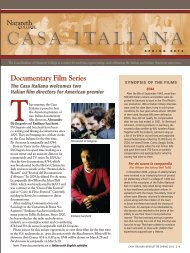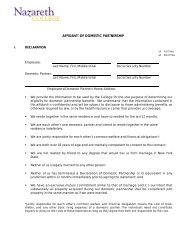the way they can make us feel, but also perhaps we believe that therationalization <strong>of</strong> our fears will help to banish the monsters andrelieve us <strong>of</strong> our anxiety. Jeffrey Jerome Cohen posits seven theses onMonster Culture. Cohen’s theses attempt to define the monstrous,and, using his ideas, it is easy to see how darkness becomes definedas a monster to be afraid <strong>of</strong>.His first thesis, entitled “The Monster’s Body is a CulturalBody,” discusses the idea that the Monster is “pure culture” (Cohen4). Cohen asserts that “The monster is born…at this metaphoriccrossroads, as an embodiment <strong>of</strong> a certain cultural moment…Themonster’s body quite literally incorporates fear, desire, anxiety, andfantasy, giving them life and an uncanny independence” (Cohen 4).While darkness has no physical body in itself, like the body <strong>of</strong> ahuman, the time <strong>of</strong> the day it represents is indeed at a crossroads, andits being easily “incorporates fear, desire, anxiety, and fantasy.” Thismakes it almost seem to be a being <strong>of</strong> living, breathing physicality,as real and touchable as another human being. When we meet thenight it is with as much belief in its danger to our well being as if wewere to meet a serial killer. Really it is no wonder, for what potentiallyhides in the shadowy darkness is absolutely terrifying. Christianitypromoted thousands <strong>of</strong> years ago the nighttime’s apparent ability toshift into a time <strong>of</strong> evil, allowing for demonic and spiritual beingsto cross over and walk the earth (Bildaur 138). This might be anoriginally religious idea, but it is thousands <strong>of</strong> years old and stillinstills real fear and terror today. Youngs and Harris note that “Thenight became home to imagined horrors” (Bildaur 135), and theseimagined horrors still exist for people in the modern day and <strong>of</strong> anyreligion, whether the fears be demonically and spiritually connectedor other manifestations <strong>of</strong> our elaborate imaginations. The darknessallows for this in between time, this place <strong>of</strong> crossroads, where, atleast in our minds, anything can happen. It is the “Quintessentialterror <strong>of</strong> the dark and its unknowns” (Bildaur 135) that leaves openlauren apt 55
the many possibilities for things to go wrong. Dreaming is anotherliminal and dangerous part <strong>of</strong> the night. This belief says that “it [thenight] was a transforming agent” (Bildaur 139) capable <strong>of</strong> changingeven the most pure, devout people into beings filled with sin anddesire through the uncontrollable temptation <strong>of</strong> the dream. Ourdreams, like our imaginations, are capable <strong>of</strong> creating whateverreality we wish, and the dreams themselves had the potential to benightmares, and to transform the night into something even morefearful than reality. These liminal crossroads created through dreamsand the ability to change seemingly ordinary things, these times <strong>of</strong>darkness where the human has the potential to choose a path <strong>of</strong> eviland sin or a path <strong>of</strong> good and purity, are cause for the “fear, desire,anxiety, and fantasy” that Cohen mentions. The desire to sin, theanxiety <strong>of</strong> potential meetings with evil beings, and the fantasy <strong>of</strong>imagination and dream for our ancestors but also for modern folkmake the monstrous body <strong>of</strong> the night a big part <strong>of</strong> culture inherentin human life and history.Cohen’s second thesis, “The Monster always Escapes,” discussesthe ability <strong>of</strong> the monster to constantly shift, change, and reappear.The monster cannot be killed, and Cohen believes that “Themonster’s body is both corporal and incorporeal; its threat is itspropensity to shift” (Cohen 5). Again, the monster is constantly ata crossroad, in between, liminal. The monster not only exists in aliminal space, but is itself liminal in its ability to be always changing,never a solid body. Darkness, <strong>of</strong> course, will always escape because onecannot hold, control, or kill Darkness. Darkness shifts into shadowand light, disappearing each day, only to reappear every night despiteour attempts to banish it with our electric lights. Darkness, just likeCohen’s monsters, can shift, survive, and constantly reappear tocreate more destruction. Nicholas Lash points out the cyclic qualities<strong>of</strong> the night, saying “The darkness <strong>of</strong> the night both falls and fades, isnever, we might say, a darkness without rhythm. Each night’s darkness56 afternoons <strong>of</strong> alterity
- Page 1 and 2:
Afternoons of Alterity A Codex of t
- Page 4 and 5:
Table of ContentsFrom Medieval Mars
- Page 6 and 7:
From Medieval Marsh Monsters toFutu
- Page 8 and 9:
imagination, we must first attempt
- Page 10 and 11: seed of monstrosity within themselv
- Page 12 and 13: essence as a monster, it seems reas
- Page 14 and 15: she bore two sons, one from the imp
- Page 16 and 17: perhaps, anti-heroes) of the futuri
- Page 18 and 19: to watch the murder and mutilation
- Page 20 and 21: and modern audiences through their
- Page 22 and 23: Works Cited“Bushwhacked.” Firef
- Page 24 and 25: Projecting Otherness ontothe Disabl
- Page 26 and 27: in any systematic structuration. An
- Page 28 and 29: The idea of the monstrous’ vulner
- Page 30 and 31: not us and are in the proximity of
- Page 32: they want to be treated. The interv
- Page 36: Monstrosity and theIrruption of Rea
- Page 39 and 40: describing his fears of this place
- Page 41 and 42: stained with sin” (Spearing 221).
- Page 43: often and at will to show man somet
- Page 46 and 47: What’s Love Got To Do With It?The
- Page 48 and 49: story than as the beginning? What f
- Page 50 and 51: It is textual content like this tha
- Page 52 and 53: through the story as the Green Knig
- Page 54 and 55: the first advocating voices for end
- Page 56 and 57: “capable of seeing things objecti
- Page 58 and 59: Darkness: The True Monster ofLitera
- Page 62 and 63: not only closes out, extinguishes,
- Page 64 and 65: and temptation, most especially for
- Page 66 and 67: hours “led to the term ‘night
- Page 68 and 69: specifically his relationship to da
- Page 70 and 71: humanization of Grendel draws the r
- Page 72 and 73: subconscious the message may be. Th
- Page 74 and 75: Serial MonstrosityEmily Mastrobatti
- Page 76 and 77: is clear that they are monsters and
- Page 78 and 79: murderer that he once was. He has b
- Page 80 and 81: of the killing, “When investigato
- Page 82 and 83: ook “contains recipes from the bo
- Page 84 and 85: asks Charles Manson to marry her, t
- Page 86 and 87: Monstrous Mothers andObjectified Da
- Page 88 and 89: and her sisters plot to kill their
- Page 90 and 91: easons for “otherness.” On top
- Page 92 and 93: The original ideas are still intact
- Page 94 and 95: objectified creature. “Cultures o
- Page 96 and 97: Works CitedAcker, P. Horror and the
- Page 98 and 99: Grendel: A Manifestation ofMedieval
- Page 100 and 101: ut never was his physicality hinted
- Page 102 and 103: to wander in the darkness and the c
- Page 104 and 105: Magic could not resurrect Grendel t
- Page 106 and 107: Works CitedBeowulf. Trans. RM Liuzz
- Page 108 and 109: The Monster Under the BedThe Creati
- Page 110 and 111:
to procreate but the accepted manif
- Page 112 and 113:
Cain had/killed his father’s son
- Page 114 and 115:
can, without a doubt, be placed int
- Page 116 and 117:
The vagina’s ability to function
- Page 118:
Ed. Barbara K. Gold, et all. Albany
- Page 121 and 122:
To understand precisely how states
- Page 123 and 124:
a strict delineation between each g
- Page 125 and 126:
monstrous and societal rules to fol
- Page 127 and 128:
Gawain is willing to accept his mis
- Page 129 and 130:
survive, challenge, and defeat. Esp
- Page 131 and 132:
governmental standards, then are we
- Page 134 and 135:
They Walk Among UsOccupational Viol
- Page 136 and 137:
sports and regard our members of th
- Page 138 and 139:
modern readers are not part of the
- Page 140 and 141:
otherness and disdain for humanity.
- Page 142 and 143:
are underpaid and for the most part
- Page 144 and 145:
Home and Spatial IdentityPhysical t
- Page 146 and 147:
closeness among the people that the
- Page 148 and 149:
Into the dark gorge I ventured; the
- Page 150 and 151:
the treasures that fill up their ho
- Page 152 and 153:
threatened by the very existence of
- Page 154 and 155:
and draped in damp, shaggy moss, an
- Page 156 and 157:
individual. Home resides within the
- Page 158:
Works CitedArmitage, Simon. Sir Gaw


